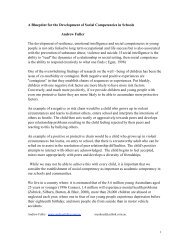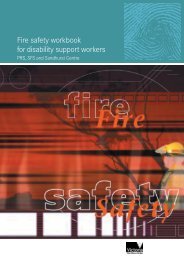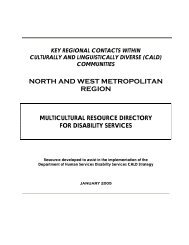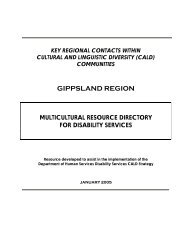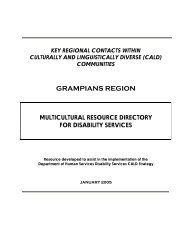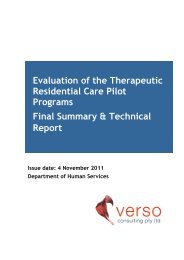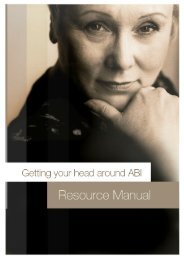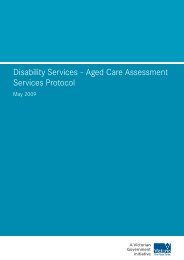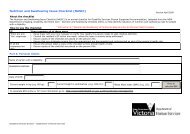Positive Behaviour Support - Department of Human Services - Vic ...
Positive Behaviour Support - Department of Human Services - Vic ...
Positive Behaviour Support - Department of Human Services - Vic ...
Create successful ePaper yourself
Turn your PDF publications into a flip-book with our unique Google optimized e-Paper software.
PowerPoint 58<br />
PowerPoint 59<br />
*<br />
*<br />
Communication<br />
<strong>Positive</strong> behaviour support: Getting it right from the start - Facilitators reference manual 41<br />
Communication is about two or more people sharing a message. It is the exchange <strong>of</strong><br />
information, thoughts and opinions between people. Communication may involve the use <strong>of</strong><br />
conventional or unconventional signals and may occur by spoken and non-spoken modes.<br />
Communication is a very complex activity, with two major processes:<br />
• Expressive communication – The sending <strong>of</strong> a message<br />
• Receptive communication – The receiving and interpreting <strong>of</strong> a message<br />
Below is a simplified diagram <strong>of</strong> what happens when two people communicate<br />
a message. 7<br />
Sender<br />
Receiver<br />
I like ice<br />
cream!<br />
Environment<br />
The diagram above shows in a simplified way an example <strong>of</strong> a successful interaction. The<br />
two-way process <strong>of</strong> communication is not always successful and not always that simple.<br />
Complex communication needs 8<br />
MESSAGE<br />
MESSAGE<br />
She likes<br />
ice cream.<br />
Chocolate<br />
is my...<br />
Receiver<br />
So Do I! Chocolate<br />
is my favourite!<br />
What is...<br />
Sender<br />
People who are unable to communicate effectively using speech alone may benefit from using<br />
augmentative or alternative communication (AAC) systems either temporarily or permanently.<br />
Hearing limitation should not be considered the primary cause <strong>of</strong> complex communication needs.<br />
Many people with a disability have complex communication needs. Often a significant proportion<br />
will show behaviours <strong>of</strong> concern as they are unable to effectively use speech or the attempts<br />
they make to communicate are difficult for their communication partners to understand. This is<br />
particularly true for people who find the usual methods <strong>of</strong> communication difficult or impossible.<br />
7. Diagram modified from Disability <strong>Services</strong> Queensland Certificate III workbook.<br />
8. Disability <strong>Services</strong> Division definition following feedback provided by people with disabilities who participated<br />
in the community consultations on complex communication needs, September 2000.



